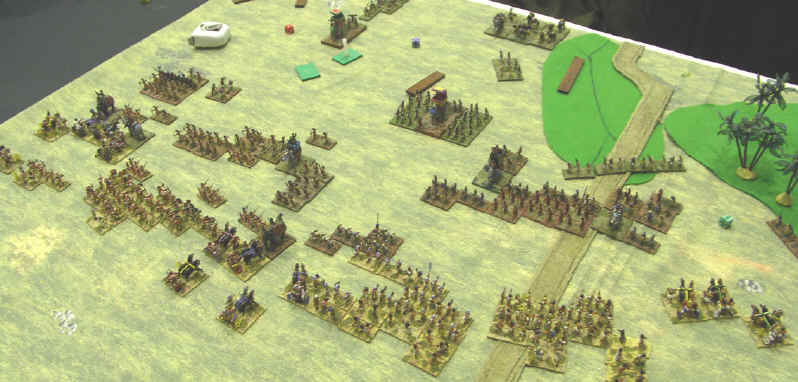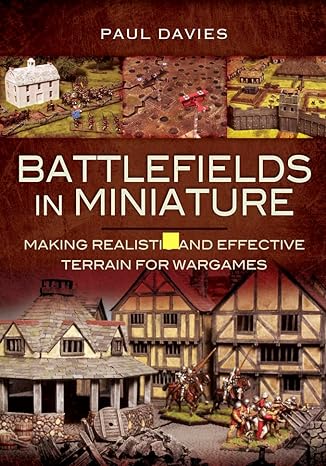BHGS Challenge 2006
Game 5 vs Sinhalese
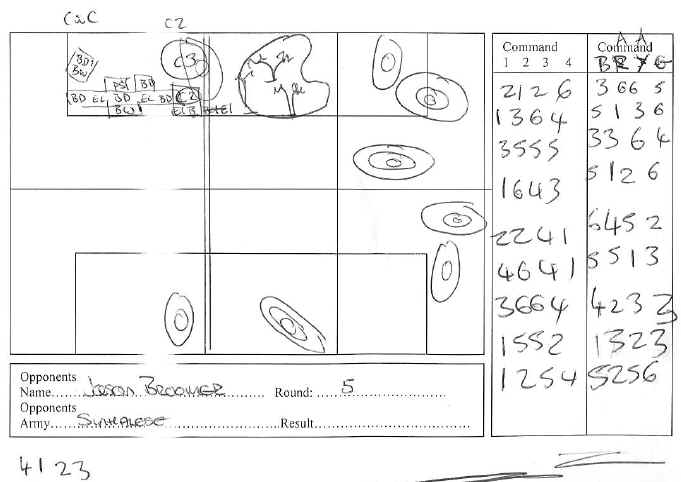
So, after muddling around mid table, I suddenly found myself propelled to the stratospheric heights of table 2, looking over a likely Reigate 5-5 Draw on the top table.
The position was not quite as it seemed - I was tied in equal 3rd with a host of other people, and Mr Simon "Bookies favorite" Hall was a good few points ahead. But all things seemed rosy in my seedless approach to the competition, and with luck and a good result for me and on the next table, there was even an outside sniff of the big prize! Not bad for my rubbish brittle army of silly hat wearers!
However, I had reason to be positive. Voila - an opponent who I had never seen on the circuit before! And with a novelty army - Sinhalese. And not even the Chola version - instead it was full of irregular blades and bows, lots of allied commands, a few elephants - but hey, who's scared of those huh? Surely this guy has lucked out and accidentally ended up at the top ? Billy Bonus time for the boy Porter !
I attacked and the terrain failed to fall kindly - none of my lovely hills (S) fell in the middle of the table, and neither did any of the Jungles of Sinhalia. Oh well. I would have to come up with another plan...
The Sinhalese deployed in a tight knot in one corner - allied commands in the middle, and each of the main commands deployed in what appeared to me to be an almost incomprehensible formation
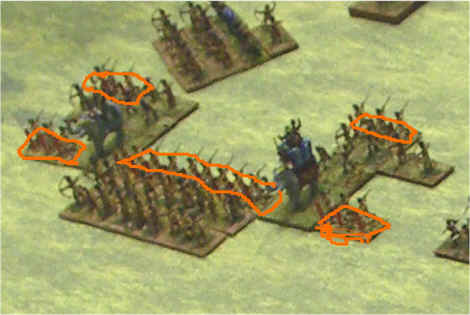 |
An Almost Incomprehensible formation for impetuous and non impetuous troops. The Irregular blades are highlighted in orange. Other elements are either Ps (O), Bw (I) or (of course) elephants. A few funny recoils and surely they are an impetuous disorganized mass ?? |
This only added to my sense that opportunity was not only staring my in the face here, it was leaning across the table unfastening its brassiere whilst eating a Cadburys flake. Slowly....
Faced by this wonderful prospect, I decided that I probably didn't really need a plan. Or maybe I could conjure on up out of thin air half way through the game.
Surely my 4 regular command dice would allow me to close in on the Sinhalese, exchange a few shots with their bowmen (killing a few, as I was (O) and they were (I), and then we could tactically outmaneuver them in a Bd vs Bd fight, feeding in my Cv as required?
I might even get to shoot down the odd elephant - after all, my army can dance better than his ?
So, bereft of any plan save "we'll be a bit cute at close range and wing it - its going to be fine!" I deployed in a big line and lurched forwards.
The Sinhalese moved like lightening ! Well, to be fair, they kind stood there and waited.
I at last came up with not one plan, but two!
First of all, it was the "advance at a slight angle so as to concentrate shooting and also mess up his possible impetuous moves". Then it was the "slip my little command round his flank and hope he doesn't get enough pips to deal with it"
Genius!
But now I had been busy brilliantly conjuring all of these ideas out of the Genius Book of Generalship, I had neglected a few other issues. Like "when faced with a larger enemy, concentrate your forces", "Look to exploit the enemy's weaknesses", and " you don't need to attack because you are the attacker".
Soon I found myself in a frantic fight along the whole frontage of my line. The Sinhalses had unsportingly refused to start the game with an exchange of missile fire, and had let loose the blades as soon as I closed to within range. I, in contrast, has relied on the shooting of my nice hat wearing guys to try and kill off a few blades before they closed in - but this had failed, and now I was fighting with MY bowmen against HIS blades as I simply did not have enough frontage to cover the whole line.
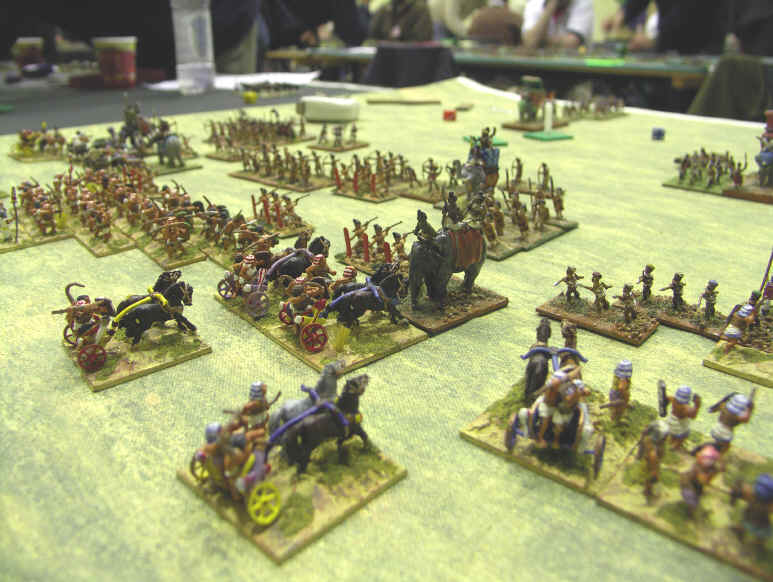
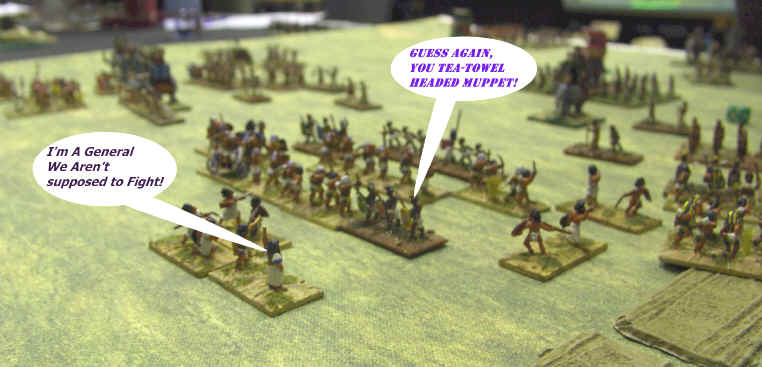
My CinC was hanging on - but defeat was now inevitable. But in the centre it was worse - what was supposed to a a supporting bystander command was fighting for its life - and doing so quite unsuccessfully! Sinhalese blades were carving their way through whatever we could throw at them with impunity and distain.
In a pathetic and badly executed heap, the Egyptian army crumbled, and was swept from the field. A weekend of skill, maneuver, and bravery consigned to the Pyramid shaped dustbin of history by a final ignominious defeat!
Post Match Summary
In retrospect I got this wrong on so many levels - and even worse, I knew I was doing it during the game as well! Underestimating an opponent (who was apparently leading the Reigate Club Championship with this army at the time!), underestimating his army, not having a plan, placing too much faith in my Bw(O) troops - probably on the basis that they were nicely painted and had done well in previous games rather than any analysis of the factors. Even attacking when I would have been far better sitting back, concentrating on one command and waiting for the pip dice to unhinge the rest of the Sinhalese army of their own accord. Oh well - competition rustiness and the end of a long weekend.... You live and learn !!
The Ancient Army List Index
The Rise of Rome (280 BC to 25 BC) Mid Republican Roman ; Late Republican Roman ; Gallic ; Pyrrhic ; Later Carthaginian ; Ancient Spanish ; Later Macedonian ; Later Seleucid ; Later Ptolemaic ; Attalid Pergamene ; Numidian or early Moorish ; Pontic ; Early Armenian ; Parthian ; Later Jewish ; Illyrian ; Spartacus Slave Revolt ; Bosporan ;
Storm of Arrows - Western Europe in the Later Middle Ages (1300 AD to 1500 AD) Medieval French ; 100-yrs War English (Continental) ; 100-yrs War English (Britain) ; Later Medieval Scots ( Britain) ; Later Medieval Scots (Continental) ; Later Scots Isles & Highlands ; Medieval Welsh ; Later Anglo-Irish ; Medieval Irish ; Low Countries ; Later Medieval German ; Italian Condotta ; Swiss ; Free Company ; Medieval Burgundian ; Medieval Danish ; Medieval Swedish ; Medieval Castilian ; Medieval Crown of Aragon ; Medieval Portugese ; Later Granadine ; Navarrese ; Ordonnance French ; Wars of the Roses English ; Ordonnance Burgundian ; Santa Hermandad Nueva Castilian
Immortal Fire - The Greek, Persian & Macedonian Wars (550 BC - 146 BC)
Classical Greek ;
Early Achaemenid Persian ;
Lydian ;
Thracian ;
Syracusan ;
Early Carthaginian ;
Skythian or Saka ;
Kyrenean Greek ;
Late Dynastic Egyptian ;
Alexandrian Macedonian ;
Later Achaemenid Persian ;
Classical Indian ;
Early Successor ;
Early Sarmatian ;
Galatian ;
Hellenistic Greek ;
Graeco-Bactrian ;
Graeco-Indian ;
Indo-Greek :
Legions Triumphant - Imperial Rome (25 BC to 493 AD) Dominate Roman ; Principate Roman ; Foederate Roman ; Later Sarmatian ; Early German ; Dacian or Carpi ; Ancient British ; Caledonian ; Early Alan ; Jewish Revolt ; Sassanid Persian ; Kushan or Indo-Skythian ; Palmyran ; Early Frankish, Alamanni, Burgundi, Limigantes, Rugian, Suevi or Turcilingi ; Western Hunnic ; Early Visigothic & Early Vandal ; Early Ostrogothic, Herul, Sciri or Taifali ; Early Anglo-Saxon, Bavarian, Frisian, Old Saxon or Thuringian ; Gepid or Early Lombard ; Early Scots Irish ; Early Pictish ; Hephthalite Hunnic ;
Swords & Scimitars - The Crusades (1096 AD to 1311 AD) Early Crusader ; Later Crusader ; Fatimid Egyptian ; Georgian ; Seljuk Turk ; Cuman ; Komnenan Byzantine ; Post Latin Conquest Byzantine ; Ilkhanid Mongol ; Mamluk Egyptian ; Cilician Armenian ; Syrian States ; Khwarazmian ; Ayyubid Egyptian ; Middle Serbian ; Middle Bulgarian ; Medieval Cypriot ; Latin Greece ; Pecheneg ;
Eternal Empire - Eastern Europe and the Rise of the Ottomans (1300 AD to 1500 AD) Early Ottoman Turkish ; Later Ottoman Turkish ; Tatar ; Later Russian ; Later Serbian Empire ; Later Bulgarian ; Later Lithuanian ; Later Polish ; Later Teutonic Knights ; Catalan Company ; Middle Hungarian ; Moldavian or Wallachian ; Albanian ; Timurid, White Sheep Turcoman or Black Sheep Turcoman ; Later Hungarian ; Hussite ;
Decline & Fall - Byzantium and Islam (493 AD to 1071 AD) Early Byzantine; Maurikian Byzantine ; Thematic Byzantine ; Nikephorian Byzantine ; Later Moorish ; Later Visigothic ; African Vandal ; Italian Ostrogothic ; Early South Slav ; Lombard ; Avar ; Arab Conquest ; Early Bulgar ; Ummayad Arab ; Abbasid Arab ; Early North African Dynasties ; Khurasanian Dynasties ; Bedouin Dynasties ; Dailami Dynasties ; Pecheneg ; Ghaznavid ; Western Turkish (includes Khazar);
Wolves From The Sea - The Hairy European Dark Ages Post Roman British ; Early Welsh ; Later Scots Irish ; Merovingian Frankish ; Later Pictish ; Early Slavic ; Middle Anglo Saxon ; Astur Leonese ; Andalusian ; Early Navarrese ; Carolingian Frankish ; Viking ; Magyar ; Great Moravian ; Early Scots ; Rus ; Norse Irish ; Early Medieval French ; Early Medieval German ; Norman ; Early Polish ; Anglo Danish ;
Swifter Than Eagles - The Biblical Book Nubian ; Early Libyan ; Later Sumerian or Akkadian ; Early Nomad Allies ; Old or Middle Kingdom Egyptian ; Hyksos ; Mitanni ; Syro-Canaanite ; New Kingdom Egyptian ; Later Minoan or Early Mycenaean ; Hittite Empire ; ; Middle or Early Neo-Assyrian ; Later Mycenaean or Trojan ; Sea Peoples ; Philistine ; Phoenician Allies ; Neo-Hittite And Aramaean ; Later Hebrew ; Mannaean Allies ; Libyan Egyptian ; Urartian ; Median ; Neo-Elamite ; Proto-Arab Allies ; Cimmerian or Early Skythian ; Neo-Assyrian Empire ; Phrygian Allies ; Kushite Egyptian ; Neo-Babylonian Empire ;
Oaf of Fealty - Early Medieval Europe Feudal Catalan and Early Crown Of Aragon ; Early Hungarian ; Taifa Andalusian ; Feudal Navarrese and Aragonese ; Feudal Castilian Leonese or Portuguese ; Fanatic Berber ; Italo-Norman ; Feudal French ; Imperial German ; Feudal German ; Communal Italian ; Papal Italian ; Early Scots Isles And Highlands ; Feudal Scots ; Early Russian ; Feudal Polish ; Anglo-Norman ; Later Welsh ; Early Lithuanian or Samogitian ; Wendish Prussian or Estonian ; Early Medieval Frisia and Other Free Cantons ; Post-Viking Scandinavian ; Early Plantagenet English ; Later Sicilian ; Early Medieval Irish ; Early Anglo-Irish ; Early Teutonic Knights ; Mongol Invasion ; Early Granadine ; Middle Plantagenet English ;
Empires of The Dragon - China, Korea and Japan Erlitou-Shang Chinese ; Early Northern Barbarian Allies ; Early Zhou Chinese ; Yayoi Japanese ; Early Horse Nomad ; Ko Choson Korean ; Warring States To Western Han Chinese ; Qiang And Di ; Three Kingdoms Korean ; Eastern Han Chinese? ; Three Kingdoms W Jin And S Dynasties Chinese ; Kofun Nara Japanese ; Northern Dynasties Chinese ; Later Hindu North Indian ; Later Hindu South Indian ; Central Asian City States ; Western Wei To Early Tang Chinese ; ; Later Horse Nomad ; Tibetan ; Nepalese Allies ; Parhae Korean ; Late Tang To Five Dynasties Chinese ; Khmer Or Champa ; Thai Allies ; Nanzhao ; Pyu Burmese Allies ; Koryo Korean ; Early Heian Japanese ; Pagan Burmese ; Liao ; Song Chinese ; Xi Xia ; Ghurid Afghan ; Jin ; Late Heian To Muromachi Japanese ; Japanese Warrior Monk Allies ; Mongol Conquest ; Moslem Indian Sultanates ; Medieval Indonesian Or Malay ; Yuan Chinese ; Medieval Burmese ; Ming Chinese ; Yi Korean
Blood and Gold - The Americas Olmec ; Teotihuacan ; West Mexican ; Zapotec or Mixtec ; Toltec ; Chinantec ; Aztec ; Tarascan ; Tlaxcalan Confederacy ; Mayan ; Mochica ; Chanca ; Chimu ; Hatun-Colla ; Canari ; Inca ; Mapuche or Araucanian ; Amazonian Forest Tribes ; Tupi ; Chichimec ; Pueblo Culture ; Mound-Builder Culture ; South-Eastern Woodland Culture ; Timucuan ; Eastern Woodland Culture ; Plains Culture ; Pacific North-West Culture




